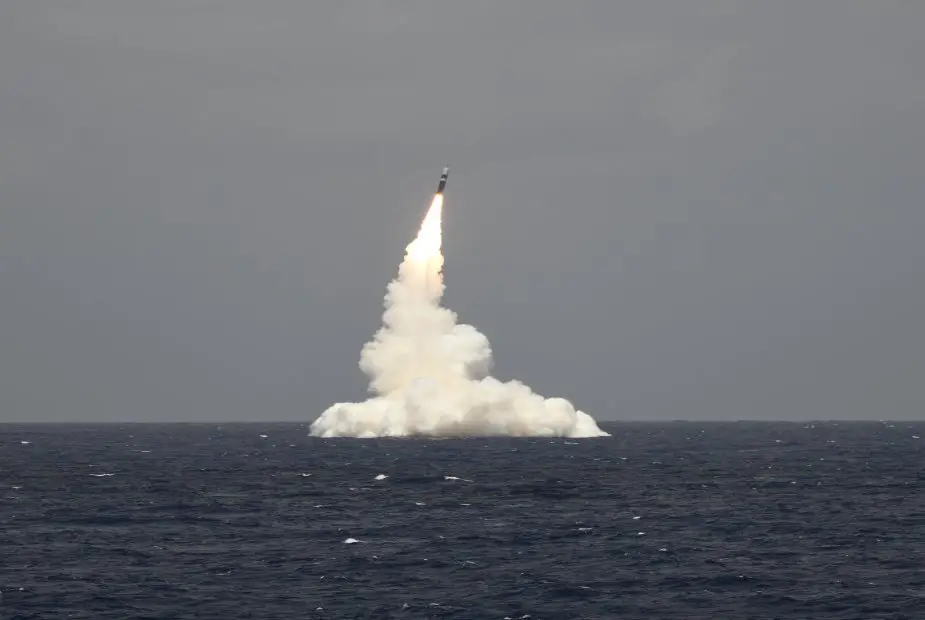Breaking news
USS Rhode Island successfully test-fired a Trident II D5 Missile.
The Ohio-class ballistic-missile submarine USS Rhode Island (SSBN 740) along with the U.S. Navy's Strategic Systems Programs (SSP) conducted a successful test flight of one unarmed Trident II D5 missile, May 9.
 An unarmed Trident II D5 missile launches from the Ohio-class ballistic missile submarine USS Rhode Island (SSBN 740) off the coast of Cape Canaveral, Florida, May 9, 2019 (Picture Source: U.S. Navy photo by John Kowalski/Released)
An unarmed Trident II D5 missile launches from the Ohio-class ballistic missile submarine USS Rhode Island (SSBN 740) off the coast of Cape Canaveral, Florida, May 9, 2019 (Picture Source: U.S. Navy photo by John Kowalski/Released)
The Ohio-class ballistic-missile submarine USS Rhode Island (SSBN 740) along with the U.S. Navy's Strategic Systems Programs (SSP) conducted a successful test flight of one unarmed Trident II D5 missile, May 9.
This launch marked the 172nd successful test flight of the Trident II D5 missile since its introduction to the fleet in 1989.
This test flight was part of a Demonstration and Shakedown Operation, designated DASO 29. The primary objective of a DASO is to evaluate and demonstrate the readiness of the SSBN's strategic weapon system and crew before operational deployment following its engineered refuelling overhaul (ERO).
“I’m incredibly proud of Team King’s Bay and the Rhode Island crew. They’ve spent the last nine months preparing for this test and the patrols that will follow. Because of their hard work and dedication, our sea-based deterrent remains the most survivable and reliable in the world,” said Rear Adm. Michael Bernacchi, Commander, Submarine Group 10.
Rhode Island completed its ERO in August 2018. An ERO is a complex, major shipyard availability during which the submarine is refueled and upgraded before returning to support the country’s nuclear deterrence strategy. This ERO extended the life of Rhode Island for more than 20 years.
EROs play a critical role in the future of the U.S. Navy’s submarine force. EROs extend the life of the ageing 14 Ohio-class submarines in the Navy’s fleet, scheduled to be replaced by 12 Columbia-class submarines, with the first initial deterrent patrol in 2031.
"USS Rhode Island’s successful test flight today demonstrates not only that this ship’s crew and shipboard weapons system are ready to return to service, but also that the sea-based leg of our nuclear deterrent remains ready, reliable and credible,” said Capt. Mark Behning, deputy director, SSP.
“While we’ve demonstrated today that our efforts to extend the life of our existing D5 missiles and SSBNs are successful, it is imperative that we remain focused on the Navy’s number one priority: on-time delivery of the first Colombia-class submarine,” said Behning.
SSP, along with Naval Ordnance Test Unit, oversees the DASO certification process and provides integrated testing and evaluation capabilities, while various other organizations provide support.
Ohio-class SSBNs carry up to 20 submarine-launched ballistic missiles, and provide the United States with its most survivable and enduring nuclear strike capability. The design allows the submarines to operate for 15 years or more between major overhauls. The Columbia-class submarine will not need to be refueled during its lifetime.
Rhode Island is the fourth U.S. Navy ship to bear the name and was commissioned July 9, 1994. Assigned to Submarine Group 10, Rhode Island is one of five ballistic-missile submarines homeported at Naval Submarine Base Kings Bay, Georgia.


























